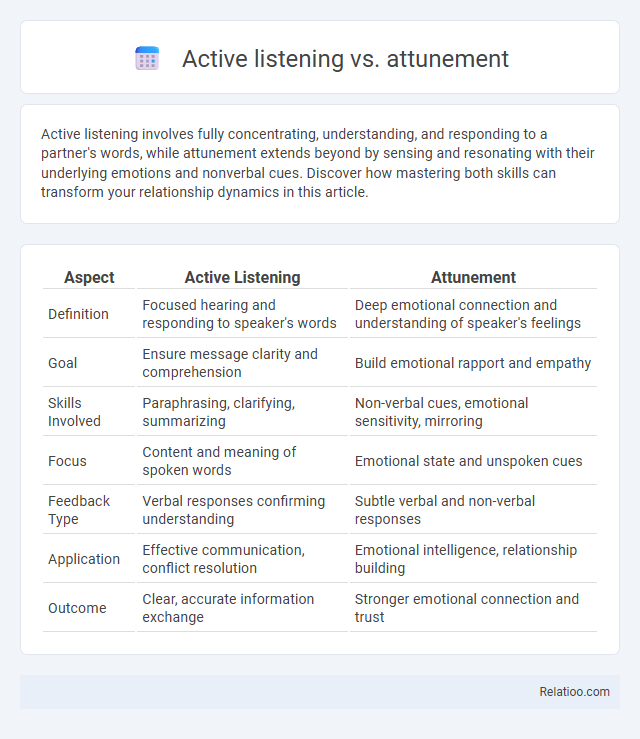Active listening involves fully concentrating, understanding, and responding to a partner's words, while attunement extends beyond by sensing and resonating with their underlying emotions and nonverbal cues. Discover how mastering both skills can transform your relationship dynamics in this article.
Table of Comparison
| Aspect | Active Listening | Attunement |
|---|---|---|
| Definition | Focused hearing and responding to speaker's words | Deep emotional connection and understanding of speaker's feelings |
| Goal | Ensure message clarity and comprehension | Build emotional rapport and empathy |
| Skills Involved | Paraphrasing, clarifying, summarizing | Non-verbal cues, emotional sensitivity, mirroring |
| Focus | Content and meaning of spoken words | Emotional state and unspoken cues |
| Feedback Type | Verbal responses confirming understanding | Subtle verbal and non-verbal responses |
| Application | Effective communication, conflict resolution | Emotional intelligence, relationship building |
| Outcome | Clear, accurate information exchange | Stronger emotional connection and trust |
Understanding Active Listening: Core Concepts
Active Listening involves fully concentrating on the speaker, understanding their message, and responding thoughtfully to foster clear communication. Attunement goes beyond by tuning into nonverbal cues and emotional states, allowing for deeper empathy and connection. Your ability to master both enhances relationship dynamics and promotes effective interpersonal understanding.
Defining Attunement in Communication
Attunement in communication refers to the deep sensitivity and responsiveness to another person's emotional state, enabling you to understand and connect with their feelings beyond just words. Unlike active listening, which primarily involves attentive hearing and verbal feedback, attunement encompasses an empathetic alignment with the speaker's nonverbal cues and emotional tone. Your ability to attune effectively fosters trust and emotional intimacy by creating a safe space where genuine understanding occurs.
Key Differences Between Active Listening and Attunement
Active Listening involves fully concentrating, understanding, and responding to the speaker's words, emphasizing verbal communication and feedback techniques. Attunement goes beyond hearing by tuning into the speaker's emotions, body language, and underlying needs, fostering a deeper empathetic connection. Key differences include Active Listening's focus on cognitive processing of information and Attunement's emphasis on emotional resonance and relational synchronization.
The Role of Empathy in Both Practices
Active listening involves fully concentrating on the speaker, ensuring your understanding through verbal and nonverbal feedback, whereas attunement goes deeper by emotionally resonating with the speaker's feelings and experiences. Empathy plays a crucial role in both practices, allowing you to connect genuinely and respond with sensitivity to underlying emotions. Mastering empathy enhances your ability to bridge communication gaps and foster meaningful relationships through both attentive listening and emotional alignment.
Benefits of Active Listening in Relationships
Active listening enhances communication by fostering empathy, reducing misunderstandings, and increasing emotional connection between partners. It encourages openness and trust, leading to stronger, more resilient relationships. Attunement, closely related, involves being emotionally in sync, but active listening specifically hones the skill of fully hearing and understanding a partner's message.
The Power of Attunement for Deeper Connections
Attunement surpasses active listening by fostering a profound emotional resonance and understanding between individuals, enabling deeper connections beyond mere words. This powerful skill involves perceiving and responding to subtle cues such as tone, body language, and emotional states, creating a synchronized interpersonal experience. Mastering attunement enhances empathy, trust, and authentic communication, which are essential for meaningful relationships and emotional intimacy.
Common Misconceptions About Active Listening and Attunement
Active listening is often misconceived as passive hearing, whereas it requires full cognitive engagement to understand and respond effectively. Attunement goes beyond active listening by involving emotional resonance and sensitivity to nonverbal cues, which many mistakenly overlook. Confusing attunement with active listening limits interpersonal effectiveness, as true attunement fosters deeper emotional connection and empathy.
Practical Techniques for Enhancing Active Listening
Active listening involves fully concentrating on, understanding, and responding to the speaker, utilizing techniques such as reflective feedback, paraphrasing, and nonverbal cues to ensure accurate comprehension. Attunement deepens this practice by emphasizing empathetic alignment with the speaker's emotional state, often achieved through mindfulness and body language mirroring to foster trust and connection. Combining these approaches enhances communication effectiveness by promoting both cognitive understanding and emotional resonance, essential in fields like counseling, leadership, and conflict resolution.
Strategies to Cultivate Attunement Skills
Effective attunement skills involve more than just active listening; they require tuning into nonverbal cues, emotional states, and underlying needs during communication. You can cultivate attunement by practicing mindfulness, observing body language closely, and responding empathetically to convey genuine understanding. Implementing regular reflective exercises and seeking feedback enhances your ability to connect deeply and respond appropriately in relationships.
Choosing the Right Approach for Effective Communication
Active listening involves fully concentrating, understanding, and responding thoughtfully to the speaker's message, enhancing clarity and trust. Attunement goes deeper by aligning with the speaker's emotional state and nonverbal cues, fostering empathy and connection in communication. Selecting the appropriate approach depends on the context and objectives, with active listening ideal for information exchange and attunement crucial for building emotional rapport and deeper interpersonal understanding.

Infographic: Active Listening vs Attunement
 relatioo.com
relatioo.com